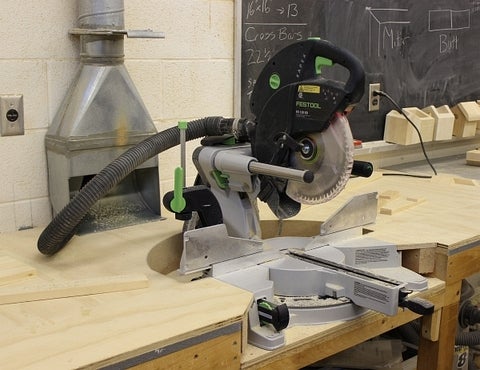Description and uses
The mitre saw is specifically designed for cross-cutting board lumber and can be easily rotated for mitre cutting up to 45 degrees off perpendicular in both directions. It proves to be the most useful stationary power tool in the woodshop since accurate mitre cuts are essential for the proper construction of painting strainers(stretchers). It is equipped with positive stops at common angles. The saw is capable of making compound mitre cuts by both rotating and beveling the blade. (Note that but this function more common to finish carpentry work like the installation of crown moldings.)
Cross-cutting/mitring
Rotate the blade to the desired angle by loosening the mitre control handle. Depress the spring loaded index lever and move the control arm until the lever locks in one of the positive stops. Always tighten the lock handle before cutting. Place the workpiece on the table and hold it firmly against the fence To start the saw, push in the switch lock key and depress the switch trigger. Cut at a slow, even rate. If the workpiece is small or if you are attempting any action that causes your hand to be within 4 inches of the blade, clamp down the workpiece to the fence before cutting. The saw will stop when you release the trigger. After your cut, clear the work area of dust and cut-offs.
Mitre saw hazards
Small pieces of wood can sometimes get wedged in the mechanism of the saw, preventing the saw from locking into a positive position or pushing the workpiece out from the fence or table. Besides affecting the accuracy of the cut, this condition could cause kick back.
Strainer (stretcher) members are often constructed from more than one piece in order to create a raised outer edge. Nails or metal hardware used in this construction may be concealed, which could result in damage to the saw or injury to the operator.
Note that precautions regarding the hazards of airborne dust are the same as with the table saw. All wood dust is carcinogenic.
Further considerations
- Ensure that the table is clear of materials, tools, and debris.
- Never attempt any freehand cutting of wood that is not held firmly against the fence and table.
- Verify location of the emergency power disconnect.
- Ensure that the table is clear of materials, tools, and debris.
Tip
If you are cutting several pieces the same length, securely clamp a stop to the worktable at the desired length using a block of wood. Push each piece up to the stop as you cut.
Cautions
- Eye protection is mandatory.
- Ear protection is required for prolonged use.
- A dust mask is recommended for plywood and particleboard and required for MDF and certain toxic woods.
- Only operators trained in the safe operation of a mitre are allowed to use the saw
- Never start machine with blade touching workpiece.
